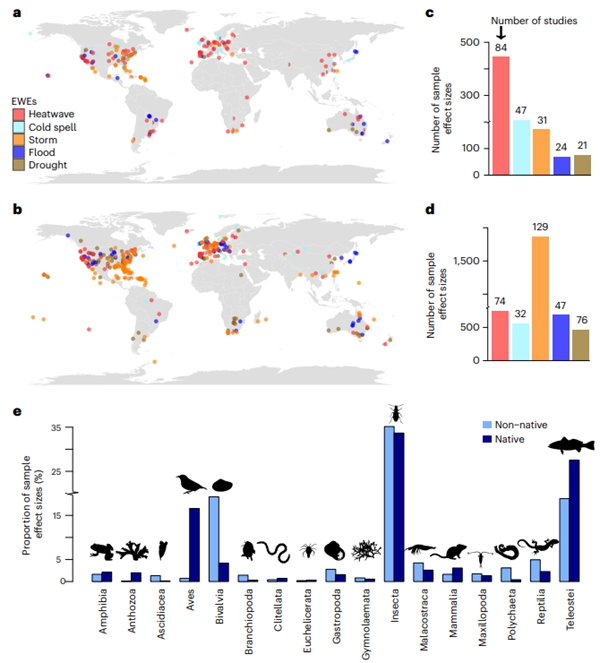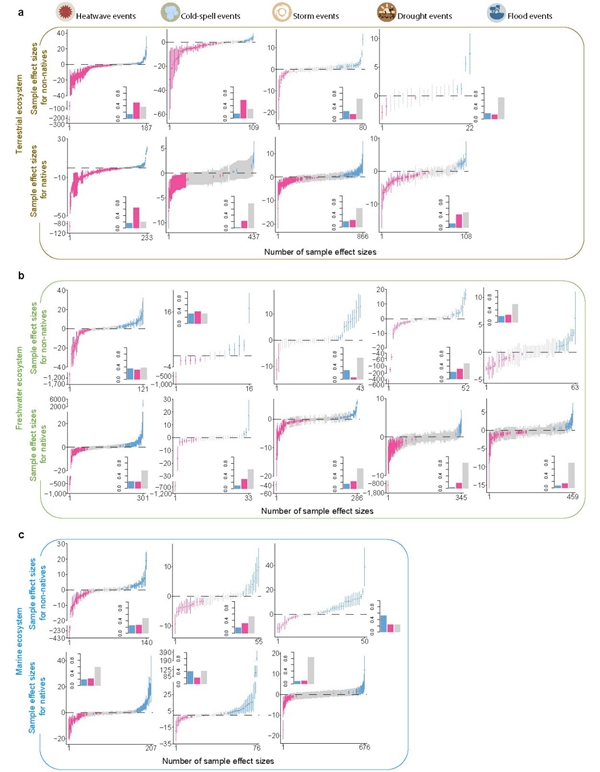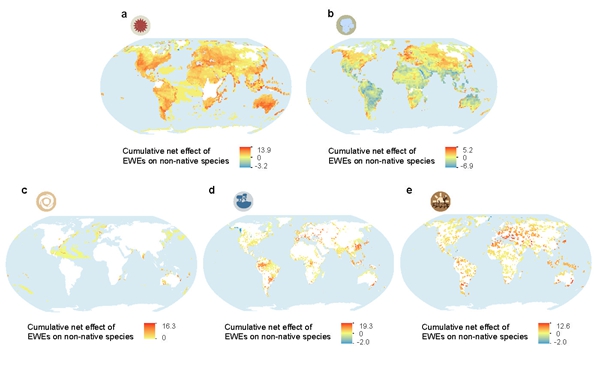Invasive species and extreme weather events (EWEs) are posing high impacts to global biodiversity, but their combined threat remains unclear, which is firstly dependent on the responses of invasive species to EWEs. Compared with native counterparts, invasive species usually have higher phenotypic plasticity, growth rate, and population recovery to quickly adapt stressful environments. It is theoretically predicted that non-native species and native species may exhibit different responses to EWEs, which, however, has never been tested in terrestrial, freshwater and marine ecosystems, covering various EWE types and response mechanisms across taxonomic groups and biogeographic regions worldwide.
A recent study led by Prof. Xuan Liu from the Institute of Zoology of Chinese Academy of Sciences revealed that extreme weathers may provide non-native species with advantages over their native counterparts. This study was published in Nature Ecology & Evolution on 6 November 2023 (16:00 GMT). Dr. Shimin Gu and master candidate Tianyi Qi are the first authors contribute equally to this work. Prof. Jason Rohr from University of Notre Dame participated in the research.
Xuan Liu and colleagues built a database covering 187 non-native and 1,852 native species experiencing different kinds of EWEs including heatwaves, cold spells, storms, floods, and droughts across seventeen classes in terrestrial, freshwater, and marine ecosystems in the past seventy years.
Based on this comprehensive dataset, their analyses using multilevel mixed-effects meta regressions showed that, overall, responses to EWEs were more often negative among native than non-native animal populations, but that responses differed depending on the type of EWEs and habitats. Both non-native and native marine animals are insensitive to EWEs, although native molluscs, corals and anemones are negatively affected by heatwaves. Non-native terrestrial and freshwater animals were only affected by heatwaves and storms, respectively, while native animals in terrestrial ecosystems respond negatively to heatwaves, cold spells and droughts, and in freshwater habitats are vulnerable to most events apart from cold spells.
Further spatial overlap analyses between EWE hotspots and existing locations of insensitive non-native species identified several locations including North America, Latin America, East and Southeast Asia, southwest Australia and New Zealand, west coast and islands in the Pacific Ocean, and North Atlantic Ocean, where native species may be particularly vulnerable to their joint impacts.
Under the limited resources that can be used to manage biological invasions and extreme weathers, this study highlights the necessary to prioritize those biodiversity conservation hotspots where EWE-tolerant non-native animals and intensified EWEs are co-occurring, so that timely mitigation strategies can be implemented for alleviating the combined threats of invasive species and climate change.

Distribution of non-native and native species under EWEs from 443 studies (Image by Shimin Gu)

A comparison of non-native (circle) and native species (triangle) responses to five different types of EWE (Image by Shimin Gu)

Overlapping areas between potential distributions of non-native species that are tolerant of EWEs and EWE hotspots worldwide (Image by Tianyi Qi)
https://doi.org/10.1038/s41559-023-02235
Contact:
Xuan Liu
Institute of Zoology Chinese Academy of Sciences
Tel: 86-64807193
E-mail: liuxuan@ioz.ac.cn
Web: http://english.ioz.cas.cn/
Article details:
Meta-analysis reveals less sensitivity of non-native animals than natives to extreme weather worldwide
DOI:10.1038/s41559-023-02235



